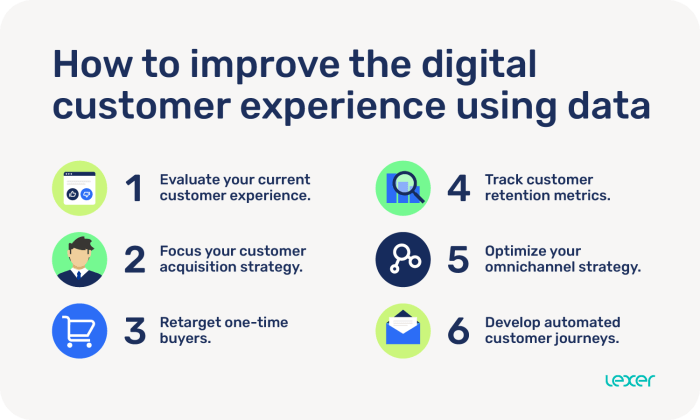Using Data to Improve Customer Experience takes center stage, bringing a fresh perspective on how businesses can leverage data to create exceptional customer interactions. Dive into the world of data-driven insights and customer satisfaction like never before.
Benefits of Using Data to Improve Customer Experience
Data plays a crucial role in enhancing customer experience for businesses. By analyzing customer behavior, preferences, and feedback, companies can tailor their products and services to meet the specific needs of their target audience. This personalized approach not only increases customer satisfaction but also fosters loyalty and repeat business.
Enhanced Customer Engagement
- By utilizing data analytics, businesses can gain valuable insights into customer behavior and preferences.
- For example, Amazon uses customer data to recommend products based on past purchases, enhancing the shopping experience and increasing sales.
- Personalized recommendations create a sense of connection with the brand, leading to higher customer engagement and loyalty.
Improved Customer Service
- Data analysis allows companies to anticipate customer needs and provide proactive support.
- For instance, airlines use data to predict flight delays and notify passengers in advance, reducing frustration and improving overall satisfaction.
- Timely and personalized communication based on data insights can significantly enhance the customer service experience.
Efficient Marketing Strategies
- By analyzing customer data, businesses can create targeted marketing campaigns that resonate with their audience.
- Netflix, for example, uses data to recommend shows and movies to users based on their viewing history, increasing user engagement and retention.
- Personalized marketing strategies result in higher conversion rates and ROI, as they are tailored to meet individual customer preferences.
Collecting Relevant Data for Customer Experience Enhancement

Understanding customer behavior is crucial for improving the overall customer experience. This can be achieved by collecting relevant data that provides insights into their preferences, needs, and expectations.
Key Data Points for Understanding Customer Behavior
When it comes to enhancing customer experience, certain key data points play a vital role in understanding customer behavior:
- Purchase history: Analyzing past purchases can help predict future buying patterns and preferences.
- Website interactions: Tracking website clicks, page views, and time spent on each page can reveal user engagement levels.
- Feedback and reviews: Customer feedback and reviews provide direct insights into their satisfaction levels and pain points.
Methods for Collecting Customer Data
There are various methods for collecting customer data to enhance their experience:
- Surveys: Conducting surveys to gather feedback and opinions directly from customers.
- Website analytics: Using tools like Google Analytics to track user behavior on the website.
- Social media listening: Monitoring social media platforms for mentions, comments, and feedback about the brand.
Importance of Data Accuracy and Reliability
Ensuring data accuracy and reliability is essential for improving customer experience:
- Accuracy leads to informed decision-making and personalized customer interactions.
- Reliability builds trust with customers and enhances brand reputation.
- Using inaccurate data can result in misguided strategies and negative customer experiences.
Analyzing Data to Enhance Customer Experience: Using Data To Improve Customer Experience

Analyzing customer data is a crucial step in improving customer experience as it helps businesses understand customer behavior, preferences, and pain points. By deriving actionable insights from this data, companies can make informed decisions to enhance their products, services, and overall customer journey.
Comparing Data Analysis Tools and Techniques
When it comes to analyzing customer data, businesses have a variety of tools and techniques at their disposal. Some popular data analysis tools include:
- Customer Relationship Management (CRM) software: CRM systems help businesses track customer interactions and data throughout the customer lifecycle.
- Business Intelligence (BI) tools: BI tools allow businesses to analyze large datasets to identify trends, patterns, and correlations that can be used to improve customer experience.
- Text analytics tools: These tools analyze unstructured text data from sources like customer reviews, social media, and surveys to extract valuable insights.
Examples of Data Analysis Impact on Customer Satisfaction
Data analysis has played a significant role in improving customer satisfaction for many businesses. For example:
- A retail company analyzed customer purchase history and browsing behavior to personalize product recommendations, leading to an increase in sales and customer loyalty.
- An airline used data analytics to optimize flight schedules based on customer demand, resulting in improved on-time performance and reduced cancellations.
- A streaming service analyzed viewer preferences to recommend personalized content, resulting in increased user engagement and retention rates.
Implementing Changes Based on Data Insights
Implementing changes based on data-driven insights is crucial for businesses looking to enhance customer experiences. Here’s a step-by-step guide on how to effectively translate data findings into actionable improvements:
Step-by-Step Guide
- Identify Key Insights: Begin by analyzing the data collected to identify patterns, trends, and customer preferences.
- Set Clear Objectives: Define specific goals and objectives based on the insights gathered from the data analysis.
- Develop Actionable Strategies: Create detailed plans and strategies to address the identified areas for improvement.
- Implement Changes: Roll out the changes across relevant departments or channels to ensure a seamless transition.
- Monitor and Measure: Continuously monitor the impact of the implemented changes and measure their effectiveness.
Role of Cross-Functional Teams
Cross-functional teams play a crucial role in translating data findings into improved customer experiences by bringing together professionals from different departments with diverse expertise. These teams collaborate to ensure that data insights are effectively utilized to drive positive changes across the organization.
Success Stories, Using Data to Improve Customer Experience
Companies such as Amazon, Netflix, and Starbucks have effectively implemented changes based on data analysis to enhance customer experiences. For example, Amazon uses personalized recommendations based on customer purchase history, Netflix analyzes viewing habits to suggest relevant content, and Starbucks leverages mobile app data to personalize promotions for customers.
